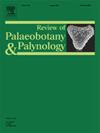First record of fossil algal diversity in Lake Sevan, Armenia: Illuminating ecological dynamics and environmental parameters
IF 1.7
3区 地球科学
Q2 PALEONTOLOGY
引用次数: 0
Abstract
Algae serve as valuable proxies for paleoenvironmental reconstructions in sedimentary environments. Fossil algae from Middle to Late Holocene sediments, alongside pollen data, enrich our understanding of environmental changes, particularly evident in the Tsovinar-1 section of Lake Sevan, Armenia.
Botryococcus and Pediastrum/Pseudopediastrum are sensitive indicators of hydrological changes and reflect fluctuations in lake level. The comparatively high abundance of Pediastrum/Pseudopediastrum and Botryococcus from 6000 BC to 4400 ca. BC, when water levels were elevated, together with the occurrence of the genera Gomphonema, Fragilaria, Cymbella, and Epithemia during high lake level phases, underscores their utility as pelagic indicators. From 4400 to 2600 ca. BC, no aquatic vegetation is recorded at Tsovinar-1 under relatively more arid conditions. Later, from 2600 to 1400 ca. BC the lake level rose again and eutrophic conditions in some shallow areas along the coastal zone developed, indicated by high abundances of the nitrogen-fixing cyanobacterium Gloeotrichia. Later, after 600 ca. BC, further variations in water level occurred and are mirrored in algal abundances. Changes of pH followed those trends of water level and are mainly reflected in the occurrences of Zygnematophyceae, particularly with high numbers of Spirogyra and Mougeotia.
The results suggest that algal species hold a valuable potential for paleoecological reconstructions, calling for further studies across diverse environmental gradients. Notably, the first documentation of Gloeotrichia in the fossil record of the Caucasus provides a new proxy for the analysis of environmental changes in lakes and pools of the Armenian Highland.
亚美尼亚塞万湖化石藻类多样性的首次记录:阐明生态动态和环境参数
藻类是沉积环境古环境重建的重要代用物。来自全新世中晚期沉积物的藻类化石,以及花粉数据,丰富了我们对环境变化的理解,特别是在亚美尼亚塞万湖的Tsovinar-1段。Botryococcus和Pediastrum/Pseudopediastrum是水文变化的敏感指标,反映了湖泊水位的波动。在公元前6000年至公元前4400年,当水位升高时,Pediastrum/Pseudopediastrum和Botryococcus的丰度相对较高,而在高水位阶段,Gomphonema、Fragilaria、Cymbella和Epithemia属的出现,强调了它们作为上层生物指标的作用。从公元前4400年到公元前2600年,在相对干旱的条件下,Tsovinar-1没有水生植被的记录。后来,从公元前2600年到公元前1400年,湖泊水位再次上升,沿海地带的一些浅水地区出现了富营养化状况,具有高丰度的固氮蓝藻Gloeotrichia。后来,公元前600年以后,水位发生了进一步的变化,反映在藻类的丰度上。pH值的变化与水位的变化趋势一致,主要体现在刺丝虫的出现上,特别是Spirogyra和Mougeotia的数量较多。结果表明,藻类在古生态重建中具有宝贵的潜力,需要在不同的环境梯度下进一步研究。值得注意的是,高加索地区化石记录中关于Gloeotrichia的第一份文件为分析亚美尼亚高地湖泊和池塘的环境变化提供了新的代理。
本文章由计算机程序翻译,如有差异,请以英文原文为准。
求助全文
约1分钟内获得全文
求助全文
来源期刊
CiteScore
3.50
自引率
21.10%
发文量
149
审稿时长
6 months
期刊介绍:
The Review of Palaeobotany and Palynology is an international journal for articles in all fields of palaeobotany and palynology dealing with all groups, ranging from marine palynomorphs to higher land plants. Original contributions and comprehensive review papers should appeal to an international audience. Typical topics include but are not restricted to systematics, evolution, palaeobiology, palaeoecology, biostratigraphy, biochronology, palaeoclimatology, paleogeography, taphonomy, palaeoenvironmental reconstructions, vegetation history, and practical applications of palaeobotany and palynology, e.g. in coal and petroleum geology and archaeology. The journal especially encourages the publication of articles in which palaeobotany and palynology are applied for solving fundamental geological and biological problems as well as innovative and interdisciplinary approaches.

 求助内容:
求助内容: 应助结果提醒方式:
应助结果提醒方式:


